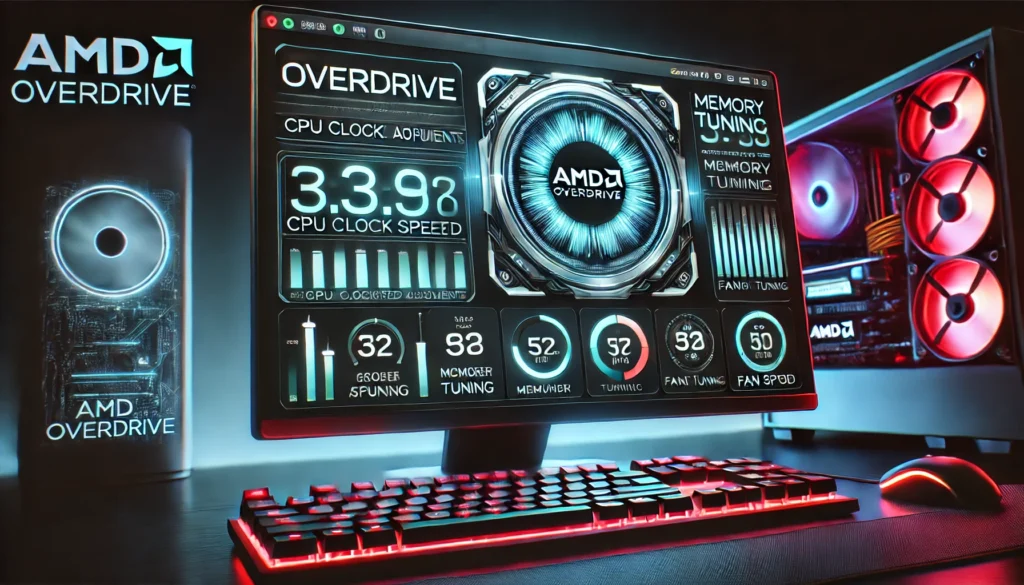Mastering AMD Overdrive: A Comprehensive Guide to Maximizing Your PC Performance

Introduction
In the world of PC enthusiasts, maximizing AMD Overdrive performance through overclocking is a crucial pursuit. If you’re using an AMD processor, AMD Overdrive is one of the most powerful tools available to help you boost your system’s capabilities. Overclocking allows users to push their hardware beyond the manufacturer’s standard specifications, often resulting in significant performance gains. For gamers, content creators, and those running demanding applications, the ability to overclock effectively can lead to smoother experiences and higher system responsiveness.
AMD Overdrive is an advanced overclocking software specifically designed for AMD processors. It provides a range of features that help users tweak the performance of their CPUs, memory, and system fans. In this guide, we will walk through everything you need to know about AMD Overdrive, from its installation to overclocking your system safely and efficiently. Whether you’re a beginner or an experienced user, this article will provide valuable insights into optimizing your PC’s performance with AMD Overdrive.
Understanding AMD Overdrive
What is AMD Overdrive?
AMD Overdrive is an overclocking utility developed by AMD to help users tune their processors for better performance. Originally designed for AMD’s older processors, it has evolved over time to support more recent models, including the popular Ryzen series. Overdrive provides a user-friendly interface to adjust clock speeds, CPU voltage, and other system settings that affect overall performance.
Unlike some third-party overclocking tools, AMD Overdrive is specifically optimized for AMD hardware, ensuring better compatibility and reliability. It gives users complete control over their system’s performance by allowing precise adjustments. For example, users can manually increase their processor’s clock speed, adjust memory timings, and even control the power delivery to their components. These features allow users to extract every ounce of performance their hardware is capable of, ensuring a smoother, more responsive system.
Key Features of AMD Overdrive
One of the standout features of AMD Overdrive is its versatility. It supports a range of AMD processors, from the older Athlon and Phenom series to the modern Ryzen 3000 and 5000 series. Some of the most notable features include:
- Core Performance Tuning: Adjust the CPU’s clock speed and voltage to push it beyond the stock settings, improving overall performance.
- Memory Tuning: Modify memory timings and frequency for enhanced RAM performance.
- Fan Control: Adjust fan speeds to maintain optimal cooling when overclocking, preventing overheating.
- Temperature Monitoring: Track the temperature of your CPU to avoid overheating while pushing your system to the limits.
Together, these features make AMD Overdrive an all-in-one tool for performance tuning, making it an essential utility for anyone serious about overclocking their AMD system.
How to Install and Set Up AMD Overdrive
Prerequisites for Installation
Before installing AMD Overdrive, it’s important to ensure your system meets the necessary requirements. AMD Overdrive works with most modern AMD processors, but it’s always a good idea to check compatibility with your specific hardware. The software runs on Windows 10 or later, and you’ll need a compatible AMD processor or chipset for full functionality. Additionally, your motherboard should support overclocking to fully leverage the capabilities of AMD Overdrive.
To ensure a smooth installation, it’s essential to have the latest drivers and BIOS updates for your system. You can find these on the official AMD website or your motherboard manufacturer’s support page. Updating these drivers ensures that AMD Overdrive works optimally and prevents compatibility issues.
Step-by-Step Installation Guide
Installing AMD Overdrive is a straightforward process. Start by downloading the software from the official AMD website. After downloading the executable file, double-click to begin the installation process. The setup wizard will guide you through the installation, and you’ll need to accept the license agreement before proceeding.
Once the software is installed, launch it from the desktop shortcut or the Start menu. The first time you run AMD Overdrive, you’ll be prompted to configure your system. The software will automatically detect your CPU and other components, making the setup process seamless. After configuration, you can start exploring the software’s interface and adjust settings as needed.
Using AMD Overdrive for Overclocking
What is Overclocking and Why Use AMD Overdrive?
Overclocking refers to the practice of increasing the operating speed of a computer’s components, particularly the CPU and RAM, beyond the manufacturer’s recommended limits. The main goal is to improve performance, making the system faster and more responsive during demanding tasks, such as gaming or video editing.
AMD Overdrive is an ideal tool for overclocking AMD processors because it allows users to make fine-tuned adjustments to clock speeds, voltages, and other critical settings. Unlike generic overclocking tools, AMD Overdrive is specifically built for AMD hardware, which provides greater stability and precision when tweaking performance. By pushing your processor and memory beyond stock speeds, you can achieve significant improvements in your PC’s performance without needing to replace any hardware.
Step-by-Step Guide to Overclocking with AMD Overdrive
To overclock with AMD Overdrive, begin by launching the software and selecting the “CPU” tab. Here, you’ll find options to adjust the CPU clock speed (measured in MHz or GHz) and voltage settings. To overclock safely, increase the clock speed in small increments and adjust the voltage accordingly. Always monitor the system’s stability after making adjustments by running stress tests like Prime95 or Cinebench.
Memory overclocking is equally important for improving overall performance. Navigate to the Memory tab in AMD Overdrive, where you can adjust the memory frequency and timings. Be cautious with memory overclocking, as pushing it too far can lead to instability. Use the stability tests to ensure the system remains stable during heavy workloads.
One of the most important aspects of overclocking is cooling. Overclocking increases the heat output of your CPU, so it’s vital to ensure that your cooling system is up to the task. AMD Overdrive allows you to control fan speeds to provide adequate cooling during overclocking.
Advanced AMD Overdrive Features

Unlocking Hidden Features in AMD Overdrive
AMD Overdrive offers a wealth of advanced features for users looking to get the most out of their system. Among these is the Memory Controller setting, which allows you to adjust the memory’s controller to better manage performance and stability at higher speeds. Additionally, the Advanced Power Management options provide granular control over your system’s power delivery, which can help improve power efficiency and reduce unnecessary heat generation.
These advanced settings are perfect for users who want to push their hardware to the limits while maintaining stability and efficiency. Experimenting with these features may lead to finding an optimal balance between performance and power consumption, especially for users looking to save energy during routine tasks.
Fine-Tuning Your System’s Performance
Another key feature of AMD Overdrive is the ability to fine-tune your system for specific tasks. For example, gamers may want to prioritize CPU performance, while content creators might need better GPU performance for video editing tasks. AMD Overdrive allows you to create custom profiles for different use cases, adjusting clock speeds and voltages to suit your needs. Whether you’re gaming, streaming, or rendering, you can quickly switch between profiles for optimal performance.
Troubleshooting Common Issues with AMD Overdrive
Common Problems and Solutions
Like any overclocking tool, AMD Overdrive can sometimes lead to system instability. If you notice crashes, freezes, or other performance issues after making adjustments, it’s important to back off on your overclocking settings. Overheating is one of the most common causes of instability, and you may need to adjust your cooling setup or lower your overclocking values.
If you encounter persistent issues or errors with AMD Overdrive, consider resetting your settings or uninstalling the software and reinstalling the latest version. Also, ensure that your drivers and BIOS are up to date, as outdated software can sometimes cause compatibility problems.
How to Reset or Uninstall AMD Overdrive
To reset your overclocking settings to their default values, simply click on the Restore Defaults button in the AMD Overdrive interface. This will undo all changes you’ve made to clock speeds and voltages, allowing your system to return to its standard configuration. If you want to completely remove the software, go to the Control Panel, select Programs, and uninstall AMD Overdrive from the list of installed programs.
Conclusion
AMD Overdrive is a powerful tool for those looking to maximize their system’s potential. Whether you’re overclocking for gaming, content creation, or simply improving system responsiveness, AMD Overdrive gives you the ability to make precise adjustments that can result in significant performance gains. While it’s important to proceed carefully and monitor system stability, the rewards of a well-tuned system can be substantial.
Frequently Asked Questions (FAQs)
- What is the difference between AMD Overdrive and AMD Ryzen Master?
- AMD Ryzen Master is a more advanced tool tailored for Ryzen processors, offering deeper customization and more control, especially for users with higher-end systems. AMD Overdrive, while more basic, is still an excellent tool for general users looking to overclock their AMD CPUs.
- Is it safe to use AMD Overdrive for overclocking?
- Yes, as long as you make gradual adjustments and monitor system stability, overclocking with AMD Overdrive is generally safe. However, pushing hardware too far without proper cooling can cause instability or damage.
- How do I check if my AMD processor is overclockable?
- You can check your processor’s capabilities on the AMD website or in your system’s BIOS. Most AMD processors are overclockable, but some lower-end models may be locked.
- Can I use AMD Overdrive on laptops?
- AMD Overdrive is primarily designed for desktop systems, but some laptops with unlocked AMD processors may also support it. Always verify compatibility with your specific laptop model.
- How can I prevent my PC from overheating when using AMD Overdrive?
- Make sure your cooling system is up to the task. Adjust your fan speeds using AMD Overdrive and monitor the CPU temperature. You may need to install better cooling solutions if your current setup isn’t sufficient.
You May Also Read: https://topblogbuz.com/dwithd00/





